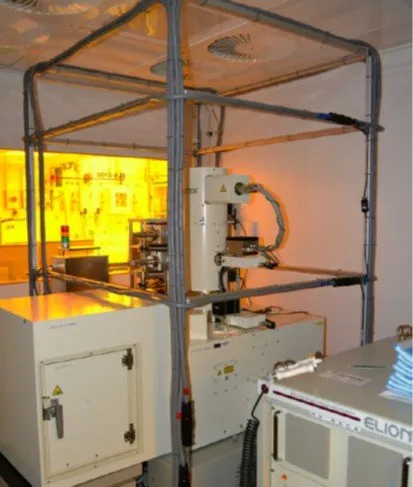A special problem requires a custom solution-UCL case study
spicerconsulting • August 14, 2020
The system comprises custom-designed high field cables in conjunction with the SC24 cancelling system.
Having a separate room for each instrument is a luxury that no one can afford. However, when it comes to electron microscopes and electron beam lithography (EBL) tools, running lots of scientific equipment in close proximity can have a detrimental effect on beam shift and image resolution due to magnetic field interference. This proved to be the case when the performance of a £2 million Elionix G100 EBL platform offering sub 10 nanometre resolution was compromised at the London Centre for Nanotechnology. The department turned to Spicer Consulting for a custom solution to magnetic field cancellation.
The London Centre for Nanotechnology (LCN) is a collaboration between University College London, Imperial College London and King’s College London, performing multidisciplinary research across chemistry, physics, materials science, medicine and engineering in all three universities, as well as other academia and industries both nationally and internationally. LCN has, since its inception in 2003, applied nanoscience and nanotechnology to global issues in healthcare, energy and the environment, and information processing.
Where the magic happens
The heart of the facility is a 255 square metre cleanroom, housing a broad selection of equipment for various processes such as photolithography, metallisation, ion milling and characterisation, as well as EBL on a RAITH150 Two. In addition, three Carl Zeiss focused-ion-beam (FIB) platforms are located in the basement lab. Suguo Huo, electron and ion beam manager, explained: “The EBL, SEM and FIB machines we work with offer highly accurate fabrication and imaging for nano-scale research, and they all require magnetic field cancellation, as ambient magnetic field interference can shift the beam and affect the accuracy of measurements. We have been using the SC24 magnetic field cancellation system from Spicer Consulting until now and its ability to cover interference up to 100 milligauss was more than sufficient.”
Trouble in paradise
In 2019, the lab received a grant for quantum computing research and used it to buy an Elionix G100 EBL, which offers better than 10 nanometre resolution. However, unfortunately, when it came to using the new platform, the scientists soon discovered that the magnetic field interference in the environment far exceeded 100 milligauss and resulted in an electron beam shift of around 1,100 nanometres.
Suguo continued: “This interference came from more than just one source, which complicated the matter. The Elionix is on the first floor just above five superconducting magnets, operating on the ground floor at high fields: 14 Tesla, 12 Tesla, 8 Tesla, 3 Tesla and 2 Tesla. Furthermore, hosting the platform on the first floor required a thick, steel brace for support in which a magnetic field was being induced. On top of that, we had also installed a new AC magnetic field furnace close to the Elionix in the cleanroom. In short, if all magnets were in operation, the combined magnetic fields and resulting interference led to a loss in performance and resolution.”
A tailored solution for a perfect fit
LCN approached Spicer Consulting for a custom solution and, after visiting the lab in April 2019 to take measurements, the team from Spicer soon discovered that the magnetic interference went as high as 550 milligauss. The interference came from five different magnets in separate locations and the lab has a complicated layout, both of which meant that finding a solution was not that straightforward and required a lot of work.
Suguo explained: “The biggest challenge during the design phase came from the fact that the room layout housing the Elionix couldn’t be altered. In addition, I needed a solution that was easy to maintain without requiring support from a third party, which basically meant that it couldn’t have too many coils. Spicer was very helpful, responding to my requests, implementing changes and, ultimately, developing a working simulation. The solution lay in using custom-designed high field cables in conjunction with the SC24 cancelling system, and it was installed successfully in September 2019.”
“We restored the platform’s resolution to better than 10 nanometres, and the machine is back up and running. There is now a solution for the worst-case scenario with all the magnets running concurrently, that was delivered within a remarkably short timeframe considering what was required. I know the people at Spicer well and they listened and understood my requirements throughout the design process; they were very helpful. If we buy more platforms and require further improvements to our magnetic field cancellation, I know I can call them, and I have no doubt that when they say they can get it done, they can get it done,” Suguo concluded.
Spicer Consulting provides solutions to reduce magnetic field interference for higher resolution electron microscopy. Contact us to find out here.
About Spicer Consulting Limited
Since it was established in 1988, Spicer Consulting has built a world-wide reputation in magnetic field cancelling for Electron Microscopes and similar instruments. Today, working with equipment manufacturers and users alike, the company is recognised as an industry expert in maximising the performance of electron microscopes, electron beam lithography systems, CD metrology and focused ion beam tools.
Spicer Consulting magnetic field cancelling systems protect sensitive equipment in the world's leading laboratories, universities and semiconductor manufacturing plants, as well as in the test facilities of electron and ion beam equipment manufacturers. Its magnetic field, vibration and acoustic analysis systems have been adopted as standard equipment for the conduct of site surveys by leading equipment manufacturers. Spicer Consulting is located in Stewartby, Bedfordshire, within the United Kingdom’s Golden Triangle of elite universities in London, Cambridge and Oxford.

